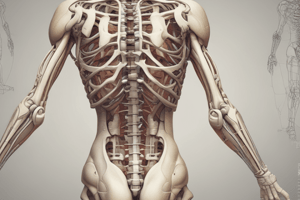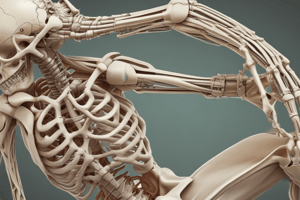Podcast
Questions and Answers
Which of the following is NOT a component of the synovial joint?
Which of the following is NOT a component of the synovial joint?
- Articular Surface
- Epiphysis (correct)
- Joint Cavity
- Joint Capsule
Match the following to the correct term
Match the following to the correct term
Fibrous layer = Outer protective layer Synovial layer = inner productive layer Joint Cavity = contains synovial fluid Synovial bursa = Fluid filled ballon providing protection to a tendon from a bone
A fluid filled sleeve that surrounds a tendon allowing easier gliding best describes
A fluid filled sleeve that surrounds a tendon allowing easier gliding best describes
- Synovial bursa
- Retinaculum
- Annular ligament
- Synovial tendon (correct)
Match the following to it's correct description
Match the following to it's correct description
The Aconeal process of the ulna fits into the ___________ of the humerus during extension
The Aconeal process of the ulna fits into the ___________ of the humerus during extension
The carpal canal connsists of the ____________, __________, and ____________
The carpal canal connsists of the ____________, __________, and ____________
The three muscles that run through the carpal canal are ______, _________, and ___________
The three muscles that run through the carpal canal are ______, _________, and ___________
Match the following to the correct term
Match the following to the correct term
Extrinsic muscles of the forelimb originate:
Extrinsic muscles of the forelimb originate:
Extinsic muscles of the forelimb insert on:
Extinsic muscles of the forelimb insert on:
The two extrinsic muscles that contribute to the thoracic sling are the serratrus ventralis m and pectoral mm.
The two extrinsic muscles that contribute to the thoracic sling are the serratrus ventralis m and pectoral mm.
The trapezius mm has 3 heads
The trapezius mm has 3 heads
The "sling muscle" refers to the ___________
The "sling muscle" refers to the ___________
The thoracic sling consists of the serratus ventralis m and the pectoral mm. What are these pectoral muscles?
The thoracic sling consists of the serratus ventralis m and the pectoral mm. What are these pectoral muscles?
Match the muscles acting on the shoulder and scapula to its correct action
Match the muscles acting on the shoulder and scapula to its correct action
The pneumonic: Let's Do This Thing refers to the Shoulder flexors. Name these shoulder flexors
The pneumonic: Let's Do This Thing refers to the Shoulder flexors. Name these shoulder flexors
The pneumonic: We flex our elbows when we play BB (basketball) refers to elbow flexors. Name these elbow flexor muscles
The pneumonic: We flex our elbows when we play BB (basketball) refers to elbow flexors. Name these elbow flexor muscles
The pneumonic: Show me your TAT refers to the elbow extensors. What are the muscles that extend the elbows?
The pneumonic: Show me your TAT refers to the elbow extensors. What are the muscles that extend the elbows?
The biceps brachii and the long head of the triceps do not act on the glenohumeral joint.
The biceps brachii and the long head of the triceps do not act on the glenohumeral joint.
The pneumonic: Please Play Saving me refers to the muscles involved in pronation or supination of the antebrachium. Name these muscles.
The pneumonic: Please Play Saving me refers to the muscles involved in pronation or supination of the antebrachium. Name these muscles.
The pronator teres m, prontator quadratus m, and supinator lie under the extensor carpi radialis m.
The pronator teres m, prontator quadratus m, and supinator lie under the extensor carpi radialis m.
The extensors of the carpus and digits originate from the _______ of the humerus
The extensors of the carpus and digits originate from the _______ of the humerus
The extensors of the carpi and digits have 4 muscles. Which of the following is considered the "traitor"; as it actually flexes the carups and digits?
The extensors of the carpi and digits have 4 muscles. Which of the following is considered the "traitor"; as it actually flexes the carups and digits?
The pneumonic : get ECLU refers to the extensors of the carpus and digits. Name these muscles
The pneumonic : get ECLU refers to the extensors of the carpus and digits. Name these muscles
The flexors of the carpus and digits originate from the ________ epicondyle of the humerus
The flexors of the carpus and digits originate from the ________ epicondyle of the humerus
Which of the following is NOT a flexor of the carpus and digits
Which of the following is NOT a flexor of the carpus and digits
The pneumonic: Fly Silly Duck Fly refers to the flexors of the carpus and the digits. Name these muscles
The pneumonic: Fly Silly Duck Fly refers to the flexors of the carpus and the digits. Name these muscles
Match the ligaments of the digits to the appropriate boxed location
Match the ligaments of the digits to the appropriate boxed location
Where does the superfical pectoral originate and insert?
Where does the superfical pectoral originate and insert?
Choose the correct origin and insertion for the deep pectoral.
Choose the correct origin and insertion for the deep pectoral.
Choose the correct origin and insertion for the Brachiocephalicus
Choose the correct origin and insertion for the Brachiocephalicus
Identify this articular surface.
Identify this articular surface.
Identify the surfaces the red and black line are referring to.
Identify the surfaces the red and black line are referring to.
Match the following to the color coded portions of scapula
Match the following to the color coded portions of scapula
Match the terms to the color coded portions
Match the terms to the color coded portions
Match the following to color coded areas
Match the following to color coded areas
Match the following to the correct colors
Match the following to the correct colors
Match the following to the correct color
Match the following to the correct color
The teres minor and latissimus dorsi are inserted on the teres major tuberosity
The teres minor and latissimus dorsi are inserted on the teres major tuberosity
What is the name of this articulation?
What is the name of this articulation?
What is the name o this outlined portion of the humerus?
What is the name o this outlined portion of the humerus?
What muscle originates in the proximal part of this groove, spirals around the bone in the groove so that distally it lies on the craniolateral surface?
What muscle originates in the proximal part of this groove, spirals around the bone in the groove so that distally it lies on the craniolateral surface?
Match to correct statement
Match to correct statement
List the lateral stabilizers of the forelimb
List the lateral stabilizers of the forelimb
Select the muscles that aid in medial stabilization of the forelimb
Select the muscles that aid in medial stabilization of the forelimb
List all the extrinsic muscles
List all the extrinsic muscles
The sternocephalicus is an extrinsic muscle
The sternocephalicus is an extrinsic muscle
List the intrinsic muscles
List the intrinsic muscles
Match to correct origin and insertion
Match to correct origin and insertion
Match to insertion points to correct muscle
Match to insertion points to correct muscle
The pronator teres originates on the medial epicondyle of the humerus
The pronator teres originates on the medial epicondyle of the humerus
The supinator originates on the medial epicondyle of the humerus
The supinator originates on the medial epicondyle of the humerus
The ________ ligament is important for claw retraction in cats. It attaches the ________ phalanx to the ________ phalanx
The ________ ligament is important for claw retraction in cats. It attaches the ________ phalanx to the ________ phalanx
What is the name of the retinaculum that holds the biceps brachii down?
What is the name of the retinaculum that holds the biceps brachii down?
What portion of the scapula does the biceps brachii originate?
What portion of the scapula does the biceps brachii originate?
The biceps brachii inserts on the ulnar and radial tuberosities
The biceps brachii inserts on the ulnar and radial tuberosities
Flashcards are hidden until you start studying
Study Notes
Synovial Joint Components
- Components of a synovial joint include articular cartilage, synovial fluid, and joint capsule.
- An example of a fluid-filled sleeve is the synovial sheath, which reduces tendon friction during movement.
Joint Structures and Terms
- The Aconeal process of the ulna fits into the trochlea of the humerus during extension.
- The carpal canal consists of the carpal bones, flexor retinaculum, and tendons of flexor muscles.
- Muscles passing through the carpal canal are flexor carpi radialis, flexor digitorum superficialis, and flexor pollicis longus.
Extrinsic Muscles of the Forelimb
- Extrinsic muscles of the forelimb originate from the axial skeleton.
- These muscles insert onto the limb bones, allowing movement of the forelimb.
- The serratus ventralis and pectoral muscles contribute to the thoracic sling, aiding in limb stability.
Shoulder and Elbow Movements
- The "sling muscle" refers to muscles that support the limb, specifically the serratus ventralis and pectoral muscles.
- Shoulder flexors are identified with the mnemonic "Let's Do This Thing" and include the biceps brachii and deltoid muscles.
- Elbow flexors associated with the mnemonic "We flex our elbows when we play BB" include the biceps brachii and brachialis.
- Elbow extensors can be remembered with "Show me your TAT," which includes the triceps brachii and anconeus.
Pronation and Supination
- For pronation and supination of the antebrachium, the mnemonic "Please Play Saving me" identifies the pronator teres, pronator quadratus, and supinator muscles.
- Extensors of the carpus and digits originate from the lateral epicondyle of the humerus and include several key muscles.
Flexors and Other Muscles
- The flexors of the carpus and digits originate from the medial epicondyle of the humerus, including flexor carpi radialis and flexor digitorum profundus.
- The mnemonic "Fly Silly Duck Fly" lists the main flexors of the carpus and digits.
- The muscle considered the "traitor" is the flexor carpi ulnaris, as it flexes rather than extends.
Ligaments and Anatomy
- Superficial pectoral originates from the cranial sternum and inserts on the humerus.
- Deep pectoral originates from the sternum and ribs, inserting along the humerus.
- Brachiocephalicus originates from the clavicular intersection and inserts on the mastoid process and the ventral neck.
Shoulder and Humeral Features
- The teres minor and latissimus dorsi insert on the teres major tuberosity of the humerus.
- Identifying the articular surfaces and markings of the humerus is crucial for understanding shoulder joint mechanics.
- A muscle that lies in the proximal groove and spirals is the teres major, originating in the axillary region.
Studying That Suits You
Use AI to generate personalized quizzes and flashcards to suit your learning preferences.




